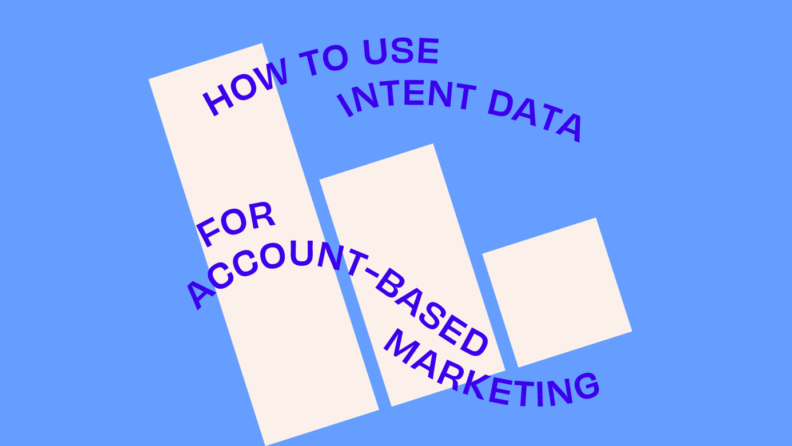In today's digital world, buyers are self-educating more than ever before when making a purchase decision. Gone are the traditional B2B marketing days when a sales rep could swoop in and close a deal with a cold call. Today, buyers are often deep into the purchase intent process, gathering information and evaluating options before ever talking to a sales person.
So you might be wondering then, how can B2B companies market themselves effectively at the early stages when buyers are silently gathering information? Well, the answer lies in account-based marketing (ABM).
What Is Account-Based Marketing?
Account-based marketing (ABM) is a targeted marketing strategy that allows B2B companies to focus their efforts on a select group of high-value accounts (aka prospective clients).
Using account-based marketing software, companies can create personalized campaigns that are tailored to the buyer’s needs and characteristics, serving relevant content that will engage key decision makers to interact and engage, ultimately leading to an increase in sales.
What Is ABM Intent Data?
ABM intent data is data that indicates an account's interest in or readiness to buy a specific product or service. It helps marketers understand target accounts better, as the data gives insight into online behavior and interests of the potential buyer. The information can also help you narrow down the right ideas for your ABM campaign to help you reach them.
Intent data can include website visits, search queries, content downloads, engagement with industry publications, and social media interactions. Essentially this data signals when you can tailor your approach, reaching the right prospective buyers at the right time, with the right messaging.
There are two main types of ABM intent data:
- First-party intent data: Collected directly by your company through your website lead forms, content downloads, and email marketing. This provides a clear view of an account list that is already interested in you.
- Third-party intent data: Collected by intent data providers who track and collect activity like web searches and website visits. These providers discover new accounts that are researching solutions like yours but haven’t interacted with you yet.
How To Use Intent Data In Your ABM Strategy
1. Gather Intent Data
The first step is to collect intent data from both first-party and third-party sources. Remember, first-party data like website activity, content downloads, and sales inquiries provide insights into accounts already engaging with you, whereas third-party data from intent providers track anonymous online activity like searches, page views, and ad clicks to uncover new accounts.
The more intent data you can gather, the better view you'll have of target accounts at various stages of the buyer's journey. By collecting data-driven information from multiple sources, you can gain a thorough understanding of the interests, preferences, and intentions of your target audience.
2. Classify Intent Data
Once the intent data has been collected, the next step to using it in your ABM strategy is to organize accounts into the right B2B market segments based on parameters like their level of intent to purchase and level of engagement.
For example, accounts actively downloading content or filling out a lead form could be marked as “sales qualified leads” (SQLs). Whereas accounts visiting pricing pages often but have not yet made any contact could be labeled as “marketing qualified leads” (MQLs). By classifying accounts into segments, you’re able to identify patterns and prioritize outreach to accounts showing the highest level of intent.
3. Identify Your Ideal Target Accounts
After you’ve classified the data, you can personify the information into buyer personas that reflect your ideal target audience. Analyzing intent-based data will allow you to uncover the accounts that are displaying the strongest buying signals and engagement. These high-intent accounts should become priority targets for your initial ABM campaigns.
Pro tip: Aim to sell to target accounts visiting key product pages, signing up for demos, and researching related topics. Identifying your ideal customer profiles and detailing key traits, such as demographics and psychographics, allows you to put resources on the accounts that are most likely to convert.
4. Personalize Your Marketing Messages
Once you’ve outlined your buyer personas, you can use the data to help you personalize your ABM messaging to each target account. For example, if intent data shows an account is interested in a specific product feature, highlight that in your ABM landing page, email or ad copy to grab their attention.
Use information on company size, industry, location to address pain points they likely have and to make it super clear that you offer a solution. Personalized web content and messages aligned to account needs and interests end up having higher engagement and conversion rates because you are delivering relevant content and offers that resonate.
5. Align Marketing and Sales
Sales teams have unique insights on target accounts that marketing teams may be unaware of. On the flipside, marketing intent data can reveal trends and interested accounts that sales aren’t aware of. That's why it's critical for marketing and sales teams to have shared visibility into intent data and align their outreach.
By utilizing intent data within the sales cycle, marketers can provide valuable intelligence about the interests and behaviors of target accounts, enabling sales reps to tailor their outreach efforts accordingly. Joint planning sessions, shared CRM data, and integrated messaging across channels ensures consistency but also leads to more effective lead generation.
6. Take a Multichannel Approach
Do not limit yourself to a single channel when engaging with target accounts. Leveraging intent data allows marketers to engage with target accounts across multiple channels and touchpoints. For example, intent data may reveal an account is highly active on social media but inactive on email, thus you’ll have to adapt the outreach appropriately.
Whether through email marketing, social media advertising, personalized website content, or targeted outreach campaigns, a multichannel approach ensures that marketers reach their audience wherever they are most active. Omnichannel coordination is key for ABM efforts as it not only increases visibility but leads to higher engagement and conversion rates.
7. Score and Nurture Leads
Intent data can be instrumental in lead scoring and lead nurturing processes. By assigning scores to accounts based on their level of engagement and intent signals, you can prioritize follow-up efforts and allocate resources efficiently.
Higher intent signals equal higher scores. Additionally, you can develop tailored nurturing strategies with content that answers common questions and objections based on their intent data, enabling you to deliver timely content to accounts at various stages of the buying journey.
The goal is to nurture accounts by providing value at each stage, not just pitch your product. Intent data informs the right nurture path per account and offers a personalized approach that helps to build relationships and foster trust.
8. Upsell and Cross-sell Where You Can
Beyond acquiring new customers, intent data can also be valuable for upselling and cross-selling to existing customers. This requires you to review intent data of existing customers to identify additional needs they may have which represent upsell or cross-sell opportunities.
For example, an account researching new use cases may be ready to expand their initial purchase or accounts displaying intent signals for complementary solutions may be open to a cross-sell offer. This proactive approach to customer engagement not only drives incremental revenue but also strengthens customer relationships, loyalty, and brand equity.
9. Track The Right ABM Metrics
When it comes to measuring the success of your ABM campaign, it will be crucial to use relevant metrics and KPIs, such as engagement rates, conversion rates and revenue generated. The key is to stay clear from vanity metrics and focus on metrics that demonstrate account engagement and traction.
Additional metrics include account reach, website visitors from target accounts, sales appointments booked, and pipeline influence. To confirm your ABM approach is driving growth, you’ll need to tie intent data to revenue and business objectives, and keep a close eye on your ABM analytics.
10. Keep An Eye on Your Competitors
Your competitors are likely using intent data in their own ABM tactics and campaigns as well. Therefore, you need to monitor their activities and overall market trends. By monitoring the online behavior of competitors' target accounts and analyzing industry-wide trends, you can stay informed about changing market dynamics and adjust strategies accordingly.
For example, if competitors are actively advertising to your target accounts, you may need to increase spend to stay top of mind. Competitive intent data gives clearer context to better understand the full landscape as you optimize ABM performance.
Fueling Your ABM Campaigns With Intent Data
The journey towards ABM program success begins with intent data as your guiding star. By leveraging these real-time insights, you can personalize your marketing efforts, engage the right accounts at the right time, and ultimately drive higher conversion rates and ROI.
Want to learn more? Subscribe to The CMO newsletter for the latest tips and insights, provided by marketers, for marketers.


